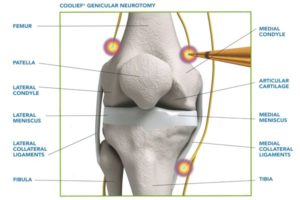Coolief Knee
COOLIEF Knee Cooled Radiofrequency for Genicular Neurotomy

COOLIEF is the first and only radiofrequency treatment cleared by the FDA for moderate to severe OA knee pain. It is a minimally invasive, non-surgical, non-narcotic procedure that treats chronic back, knee, and hip pain and can last for up to a year (for some people with chronic back pain, up to two years). Because it can be performed in an outpatient setting, patients have the potential to return to an enhanced quality of life much sooner than with surgery — and with a reduced need for narcotics. See Patient Brochure
- Clinical studies of cooled RF addressing other sources of pain have demonstrated over 20 months of pain relief and improved physical function
- Is designed to treat complex anatomy of variable nerve courses through the creation of large volume, spherical lesions
- Potentially reduces the amount of time and fluoroscopic exposure through straightforward, familiar placement techniques
Indications
Chronic knee osteoarthritis (OA) is one of the most common diseases of advanced age. With up to 20 million adults in the US suffering from OA of the knee, close to 700,000 cases progress to total knee joint replacement. However, there exists a large demographic of chronic joint pain patients who are not candidates for invasive procedures due to BMI, age and other comorbidities. Alternative therapies such (as) arthroscopic debridement or injections are associated with less than optimal clinical outcomes.
Details
Mechanism of Action
The top 6 ways COOLIEF cooled radiofrequency ablation can help with chronic pain
1. Pain relief for up to 12 months
In clinical studies, most patients receiving COOLIEF* reported that their pain was significantly reduced.
2. Improved mobility
COOLIEF* has been proven to significantly improve long-term physical function and quality of life for OA knee patients for up to 12 months.
3. Quick recovery time
Because the procedure is minimally invasive, most patients can expect to feel pain relief within 1-2 weeks, returning to an enhanced quality of life much sooner than with surgery.
4. No opioid recovery medication
You may experience some discomfort for a short period, but this discomfort can be treated with common over-the-counter medication.
5. No overnight hospital stay
Since this outpatient treatment requires no general anesthesia, you can return home shortly after treatment.
6. No incision
Unlike surgery, COOLIEF* involves no incision.
Procedure
During the days before surgery, a doctor may recommend that a person avoids taking drugs that make it hard for blood to clot, such as aspirin and warfarin. On the day of surgery, a person will probably be told not to eat or drink anything for several hours before the procedure. A person can take any medication a doctor approves, along with sips of water.
A surgeon will perform Coolief procedure in a hospital. Patient are sedated using monitored anesthesia. The surgical procedure is as follows:
- Patient is positioned in a comfortable position
- Anesthesia is induced by an attending anesthesiologist
- Fluoroscopic images (X-Ray) is used to identify the site of cannula position
- Cannula (needle) is placed under live fluoroscopic guidance to the target
- Radiofrequency RF probes are placed through the cannulas
- RF probes are connected to a generator
- Various safety steps are conducted to confirm accurate location
- RF lesions are created, cannulas are removed and small band-aids are applied at sites
- Patient is taken to recovery area
Risks and complications
The most common side effect is a transient sunburn-type pain at the treatment site. This is a superficial burning pain, like a sunburn, that occurs for 3-5% of patients. The pain is not severe, but it can be troublesome and last for several weeks.
- Less common in the mid and low back than in the neck
- Most common at higher levels of the neck
- Can be treated with topical medication or oral medications
For 2-3 weeks following the procedure, you may experience the following temporary side effects:
- Soreness at treatment site
- Muscle spasms or irritability at treatment site
- Swelling
- Bruising
- Numbness
RARE COMPLICATIONS & SIDE EFFECTS OF COOLIEF
- Infection
- Bleeding
- Increased pain
- Nerve damage
- Allergies or reactions to medications used
Credits & Sources:
- Avanos
- www.CDC.gov/arthritis/osteoarthritis.htm
- MedTech Insights: U.S. Market for Joint Replacement and Reconstruction, June 2011.
- Stelzer W. MD, Use of Radiofrequency Lateral Branch Neurotomy for the
Treatment of Sacroiliac Joint-Mediated Low Back Pain: A Large Case Series. Pain Medicine,2013 Jan (1)29-35. - Masahiko Ikeuchi, MD, PhD, et al. Percutaneous Radiofrequency Treatment for Refractory Anteromedial Pain of Osteoarthritic Knees. Pain Medicine, 2011; 12:546–551.


